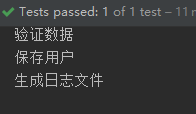使用springaop时需要注意,如果bean对象,即service层的对象没有实现接口的话,使用spring-aop的话会报错,因此需要在service层创建接口。
spring-aop的基层是基于动态代理来实现的,动态代理的实现有两种方式:
1.jdk动态代理
spring模式默认使用jdk动态代理,jdk动态代理要求目标类的对象必须实现一个接口,而且获取目标类对象的时候要做向上转型为接口。
2.cglib动态代理
cglib代理方式spring aop也支持,cglib实现动态代理的时候,不需要目标类实现接口,如果要把spring aop的代理方式改为cglib,需要如下配置:

proxy-target-class如果设置成true使用cglib动态代理,默认是false使用jdk动态代理。
spring的五种通知类型:
| 通知类型 | 说明 |
| aop:before 前置通知 | 在目标方法调用之前执行 |
| aop:after-returning后置通知 | 在目标方法调用之后执行,一旦目标方法产生异常不会执行 |
| aop:after 最终通知 | 在目标调用方法之后执行,无论目标方法是否产生异常,都会执行 |
| aop:after-throwing 异常通知 | 在目标方法产生异常时执行 |
| aop:around 环绕通知 | 在目标方法执行之前和执行之后都会执行,可以写一些非核心的业务逻辑,一般用来替代前置通知和后置通知 |
使用注解的方式配置spring-aop:
1.创建通知类
package com.zs.advice; import org.aspectj.lang.annotation.After; import org.aspectj.lang.annotation.AfterThrowing; import org.aspectj.lang.annotation.Aspect; import org.aspectj.lang.annotation.Before; import org.springframework.stereotype.Component; /** * 用户业务通知 */ @Component @Aspect public class UserAdvice { @After("execution(void *User(..))") public void log() { System.out.println("生成日志文件"); } @Before("execution(void *User(..))") public void yanzheng() { System.out.println("验证数据"); } @AfterThrowing(pointcut = "execution(void *User(..))",throwing = "e") public void error(Exception e) { System.out.println("异常处理"); } }
2.spring配置文件中声明使用注解的方式配置spring-aop;
<?xml version="1.0" encoding="UTF-8"?> <beans xmlns="http://www.springframework.org/schema/beans" xmlns:xsi="http://www.w3.org/2001/XMLSchema-instance" xmlns:aop="http://www.springframework.org/schema/aop" xmlns:context="http://www.springframework.org/schema/context" xsi:schemaLocation="http://www.springframework.org/schema/beans http://www.springframework.org/schema/beans/spring-beans.xsd http://www.springframework.org/schema/aop http://www.springframework.org/schema/aop/spring-aop.xsd http://www.springframework.org/schema/context http://www.springframework.org/schema/context/spring-context.xsd"> <!--声明service对象--> <bean id="userService" class="com.zs.service.impl.UserServiceImpl"/> <!--扫描通知类包--> <context:component-scan base-package="com.zs.advice"/> <!--声明以注解的方式配置spring-aop--> <aop:aspectj-autoproxy/> </beans>
3.测试
import com.zs.entity.User;
import com.zs.service.UserService;
import org.junit.Test;
import org.springframework.context.support.ClassPathXmlApplicationContext;
public class AopTest {
private ClassPathXmlApplicationContext context = new ClassPathXmlApplicationContext("spring.xml");
@Test
public void fun1() {
UserService us = (UserService) context.getBean("userService");
us.saveUser(new User());
}
}
结果如下:
